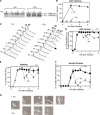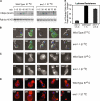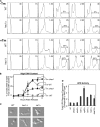A novel role in cytokinesis reveals a housekeeping function for the unfolded protein response
- PMID: 17562790
- PMCID: PMC2064362
- DOI: 10.1083/jcb.200702101
A novel role in cytokinesis reveals a housekeeping function for the unfolded protein response
Abstract
The unfolded protein response (UPR) pathway helps cells cope with endoplasmic reticulum (ER) stress by activating genes that increase the ER's functional capabilities. We have identified a novel role for the UPR pathway in facilitating budding yeast cytokinesis. Although other cell cycle events are unaffected by conditions that disrupt ER function, cytokinesis is sensitive to these conditions. Moreover, efficient cytokinesis requires the UPR pathway even during unstressed growth conditions. UPR-deficient cells are defective in cytokinesis, and cytokinesis mutants activate the UPR. The UPR likely achieves its role in cytokinesis by sensing small changes in ER load and making according changes in ER capacity. We propose that cytokinesis is one of many cellular events that require a subtle increase in ER function and that the UPR pathway has a previously uncharacterized housekeeping role in maintaining ER plasticity during normal cell growth.
Figures






References
-
- Arnold, E., and W. Tanner. 1982. An obligatory role of protein glycosylation in the life cycle of yeast cells. FEBS Lett. 148:49–53. - PubMed
-
- Brill, J.A., G.R. Hime, M. Scharer-Schuksz, and M.T. Fuller. 2000. A phospholipid kinase regulates actin organization and intercellular bridge formation during germline cytokinesis. Development. 127:3855–3864. - PubMed
-
- Casagrande, R., P. Stern, M. Diehn, C. Shamu, M. Osario, M. Zuniga, P.O. Brown, and H. Ploegh. 2000. Degradation of proteins from the ER of S. cerevisiae requires an intact unfolded protein response pathway. Mol. Cell. 5:729–735. - PubMed
-
- Chapman, R., C. Sidrauski, and P. Walter. 1998. Intracellular signaling from the endoplasmic reticulum to the nucleus. Annu. Rev. Cell Dev. Biol. 14:459–485. - PubMed
Publication types
MeSH terms
Substances
LinkOut - more resources
Full Text Sources
Molecular Biology Databases

